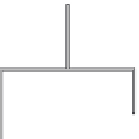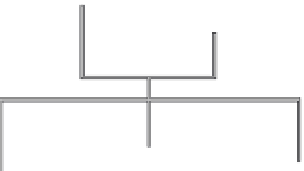Biomedical Engineering Reference
In-Depth Information
T
x
1
B
2
K
se
x
2
B
1
K
lt
F
FIGURE 13.38
An updated linear muscle model consisting of an active-state tension generator
F
in parallel
with a length-tension elastic element
K
lt
and viscous element
B
1
, connected to a series elastic element
K
se
in parallel
with a viscous element
B
2
. Upon stimulation of the active-state tension generator
F
, a tension
T
is exerted by the
muscle.
The need for two elastic elements in the linear oculomotor muscle model is supported
through physiological evidence. As described previously, the use and value of the series
elasticity
were determined from the isotonic-isometric quick release experiment by
Collins. Length-tension elasticity
K
se
was estimated in a slightly different fashion than before
from the slope of the length-tension curve. Support for the two linear viscous elements is
based on the isotonic experiment and estimated from simulation results presented in this
chapter.
K
lt
13.7.2 The Length-Tension Curve
The basis for assuming nonlinear elasticity is the nonlinear length-tension relation for
excited and unexcited muscle for tensions below 10 g, as shown in Figure 13.14.Usinga
miniature “C” gauge force transducer, Collins in 1975 measured muscle tension in vivo at
the muscle tendon during unrestrained human eye movements. Data shown in Figure 13.14
were recorded from the rectus muscle of the left eye by measuring the isometric tensions
at different muscle lengths, ranging from eye positions of
45
to 45
, and different levels
of innervation, established by directing the subject to look at the corresponding targets with
the unhampered right eye from
45
temporal (T) to 45
nasal (N). The change in eye posi-
tion during this experiment corresponds to a change in muscle length of approximately
18 mm. Collins described the length-tension curves as “straight, parallel lines above about
10 g. Below the 10 g level, the oculorotary muscles begin to go slack.” He also reported that
the normal range of tensions for the rectus muscle during all eye movements never falls
below 10 g into the slack region when the in vivo force transducer is used.





















































